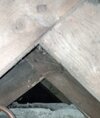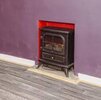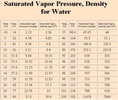Good Morning and thank you for allowing me to join te forum. I think I might be quite active over the next few weeks as I work to bring our new property, (soon we hope, our forever home) up to a comfortable standard. We live in the rural south of Scotland where installation services are scarce and winters can be challenging. For background, our property was built in at least five stages over one and a half centuries. The last but one owner installed an Air Source Heat Pump but was ill advised as no insulation was installed with it. Curiously, that may have done us an expensive favour as it forced a much closer examination of the fabric than might otherwise have been the case.
My first question to the forum relates directly to the comment in the Home Report for the property that damp readings were high near the base of a chimney breast. It was only when I started to investigate that it became clear the the Home Report left something to be desired, indeed, many things! One issue missed was the four chimney breasts in the property did not match the three chimneys on top. Had the surveyor noticed this he might also have noted the chimney breast with no chimney was the one which demonstrated high damp levels.
Yesterday we managed to reach the top of the chimney breast in the loft and it looks (haven't been able to get a camera completely over the chimney yet} as if the chimney is open. while the loft is apparently quite dry it is. of course, unheated and our weather in the south of Scotland this year hasn't been exactly dry. In addition, the report was written in January with snow on the roof and the house has now been empty ofr ten months. The bottom of the chimney lies above a framed and dry lined faux fireplace with an electric fire fitted into it.
We are in the process of planning the installation of underfloor heating so the room will be properly heated. We plan to dispose of the electric fire, frame and dry line the faux fireplace over its face. I have three questions:
1. Should we block and seal the chimney top and bottom?
2. Should we fill it and if so with what
3. Is it a reasonable assumption that proper heating, particularly the steady heat of UFH. will allow the damp (which is not visible) to dry naturally?
My first question to the forum relates directly to the comment in the Home Report for the property that damp readings were high near the base of a chimney breast. It was only when I started to investigate that it became clear the the Home Report left something to be desired, indeed, many things! One issue missed was the four chimney breasts in the property did not match the three chimneys on top. Had the surveyor noticed this he might also have noted the chimney breast with no chimney was the one which demonstrated high damp levels.
Yesterday we managed to reach the top of the chimney breast in the loft and it looks (haven't been able to get a camera completely over the chimney yet} as if the chimney is open. while the loft is apparently quite dry it is. of course, unheated and our weather in the south of Scotland this year hasn't been exactly dry. In addition, the report was written in January with snow on the roof and the house has now been empty ofr ten months. The bottom of the chimney lies above a framed and dry lined faux fireplace with an electric fire fitted into it.
We are in the process of planning the installation of underfloor heating so the room will be properly heated. We plan to dispose of the electric fire, frame and dry line the faux fireplace over its face. I have three questions:
1. Should we block and seal the chimney top and bottom?
2. Should we fill it and if so with what
3. Is it a reasonable assumption that proper heating, particularly the steady heat of UFH. will allow the damp (which is not visible) to dry naturally?




